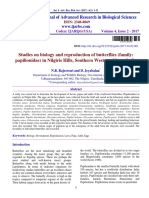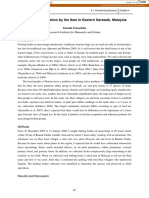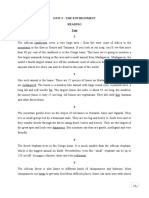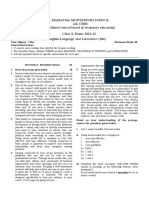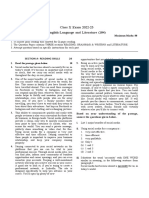Dispoyrous Eboneum Tree
Dispoyrous Eboneum Tree
Uploaded by
Mani VannanCopyright:
Available Formats
Dispoyrous Eboneum Tree
Dispoyrous Eboneum Tree
Uploaded by
Mani VannanOriginal Description:
Original Title
Copyright
Available Formats
Share this document
Did you find this document useful?
Is this content inappropriate?
Copyright:
Available Formats
Dispoyrous Eboneum Tree
Dispoyrous Eboneum Tree
Uploaded by
Mani VannanCopyright:
Available Formats
See discussions, stats, and author profiles for this publication at: https://www.researchgate.
net/publication/322782682
Diospyros ebenum
Chapter · January 2018
DOI: 10.1002/9783527678518.ehg2015001
CITATIONS READS
0 7,850
2 authors:
Joachim Schmerbeck Niyati Naudiyal
Freelance consultant 24 PUBLICATIONS 105 CITATIONS
36 PUBLICATIONS 259 CITATIONS
SEE PROFILE
SEE PROFILE
Some of the authors of this publication are also working on these related projects:
Acacia auriculiformis View project
Ecosystem functions and services in Delhi: Regeneration under the canopy of Prosopis juliflora View project
All content following this page was uploaded by Niyati Naudiyal on 14 May 2018.
The user has requested enhancement of the downloaded file.
Diospyros ebenum
III-4
Diospyros ebenum J. KOENIG EX RETZ., PHYSIOGR.
SÄLSK. HANDL. 1: 176 (1781)
syn.: Diospyros ebenaster Retz., Observ. Bot. 5: 31 (1788), Diospyros glaberrima
Rottler, Nye Saml. Kongel. Vidensk. Danske Selsk. Skr. 2: 539 (1783), Diospyros
melanoxylon Willd., Sp. Pl. 4: 1109 (1806), nom. illeg., Diospyros membranacea
A.DC. in A.P. de Candolle, Prodr. 8: 227 (1844), Diospyros reticulata var. timori-
ana A.DC., Prodr. 8: 225 (1844). Diospyros laurifolia A. Rich. in R. de la Sagra,
Hist. Fis. Cuba, Bot. 11: 86 (1850), Diospyros timoriana (A.DC.) Miq., Fl. Ned.
Ind. 2: 1045 (1859), Diospyros assimilis Bedd., Rep. Forest. Madr.: 20 (1866) [25]
Ebony Family: Ebenaceae
Span.: El ébano
French: Ébène
German: Ebenholz
Hindi: Kendhu
Tamil: Karunkaali,
Solaikarimaram,
Thumaraam,
Velleithuvarai,
Vellathovarai
Telugu: Tuki
Sinhala: Kaluwara
Figure 1: Diospyros ebenum. Vigorous young tree in
the Angamedille National Park Sri Lanka.
Enzyklopädie der Holzgewächse – 69. Erg. Lfg. 01/17 1
Diospyros ebenum
III-4
High-quality wood has always been in demand in human [35] observed the species in the Kurrukpoor Hills near
societies. It is loved and used extensively by those who Munger, which today is the Munger District (Bihar), and
can afford it. In Egypt, ebony was most likely used as ear- Singh [36] states that the species occurs in Kerala and
ly as 4500 years B.P. [11], and later, the Roman Empire even in Assam and the Andaman and Nicobar Islands.
also developed a high demand for ebony wood. Much One of the most astonishing features of the species is the
of this demand was satisfied by the Indian Diospyros wide range of annual precipitation that it is found ranging
species [41]. The two ebony species mainly traded from from 750 mm [34] to more than 7000 mm [2]. The spe-
India were D. melanoxylon and D. ebenum. However, cies has been observed near Agumbe, Karnataka, where
the latter is the “only one giving a black wood without the annual precipitation is as high as 7000 mm [14]. This
other streaks or markings …” [13]. The wood was first prompts the question of what limits the species from
brought to Rome around 2000 years ago [41] and was distributing across an even wider area. One explanation
traded with rulers of the Europe during the Renaissance. could be the change in rainfall pattern, e.g., from a dis-
Around 400 years ago, the term “ebenist” was used for symmetric to a tropical rainfall regime, which occurs when
the finest carpenters of France [9]. For millennia, ebony moving from the south of India to the north. This change
has been harvested in India so that by the time of the is reported by Meher-Homji [27] as being the limitation
British arrival a large percentage of the ebony was al- for the extension of the dry evergreen forest communities
ready cut, mostly by using very destructive methods [37]. of which D. ebenum is a part. However, this climatic pat-
Because of this, not much of the species was left on the tern driving the distribution can be doubted as both re-
subcontinent [13], and the still plentiful stocks in Sri Lan- gimes occur in the area where the species is distributed. In
ka (then Ceylon) were the main source for the British of this context, it has to be recalled that the species has been
this much-in-demand wood. Some of these stocks remain exploited for thousands of years and that anthropogenetic
today, even though they were heavily exploited. pressure can be expected to have a stronger influence than
Despite the high value of the species and the potential that climatic or edaphic factors. A previous, larger range of the
the species promises with scientific management, it does species is therefore likely.
not receive much attention from the scientific world. The There are some indications of D. ebenum occurrence out-
species is classified as endangered in Sri Lanka [21] and side of India: Prinz [32] states that it occurs in the jungle
its trade is banned in both India and Sri Lanka. However, of Nigeria, but the probability is high that the identifi-
in the course of the forest ecosystem restoration work in cation is not correct, as many Diospyros species exist in
South India, the species is used and distributed. Africa. However, its occurrence in gardens is likely, as
reported by Delchevalerie [10] from gardens in Egypt.
The word “Diospyros” is of Greek origin: dios meaning
Distribution and Forest History “divine” and pyros meaning “fire” or “burned”, which
would make the meaining of “divine fire”. Such a mean-
The natural and present-day distribution of the species is ing cannot be explained by the author. Dahms [9] states
in South India and Sri Lanka [26]. In Sri Lanka, Broun that pyros means “corn/grain” and the word “Diospyros”
[6] observed the species in forests all over the island. Al- would therefore mean “divine food”, but evidence for
though it was most abundant in dry forests, it also ap- such a translation could not be found. The name “eb-
peared in moist forests in the south of the island. A de- ony” seems to have its root in the Egyptian word hbny
tailed description of the species in Sri Lanka today is not [11]. This entered the Greek language where the word
known to the authors. ebenos was used for the dark woods that came from
The species distribution in India can be outlined more India or Egypt [9]. From the 17th century onwards, the
clearly based on several studies made in South India. word was adopted by European languages (e.g., French
The species can potentially occur in all forest types in ébène, Spanish ebano, German Ebenholz). Most likely,
the plains of Tamil Nadu and southern Karnataka as the deepest incorporation of the word ebony in a Eu-
well as in the Eastern Ghats and the eastern slopes of the ropean language took place in France where the word
Western Ghats. Beddome [3], Brandis [5] and Gamble “ébéniste” means carpenters who make very fine furni-
[13] report the presence of the species in Andhra Pradesh ture (cabinet makers) [9]. According to the same author,
(mainly in the Cuddapah and Karnool Districts where the old Egyptian name also influenced the development
the tree, according to Beddome [3], “is very common of the scientific name, which was first given in 1737 by
and well known”), and Haines [17] described the species the botanist N. L. Burgmann as “Ebenus Burm.”. In
to occur even further north in the Champagarh forest, 1778, Johann Gerhard Koenig, a Danish botanist
which today is the Similipal National Park (Khurda dis- who worked with Linnaeus, sent a letter from Tranque-
trict), as well as in the Angul district (Orissa). Sherwill bar (India) to Prof. Rottboel, who was the “chief of
2 Enzyklopädie der Holzgewächse – 69. Erg. Lfg. 01/17
Diospyros ebenum
III-4
Figure 2: Distribution of Diospyros ebenum according to records found by the authors. The natural distribution is likely to
cover a much wider area.
botany in the Chair of Medicine in Copenhagen”, stating states that it was “most improbable that ebony should
that he recently completed a journey to Ceylon where he have been obtained from India or Ceylon at such an early
discovered the true ebony [19]. The establishment of the period …” and places a trade of “such material” at the
actual scientific name by Koenig is described in detail by earliest in the 18th dynasty (around 1500 B.C.). Dixon
Howard and Norlindh [20] who also described how [11], however, doubts this statement as trade between In-
the name “Diospyros ebenaster” appeared as a synonym dia and Egypt with precious stones existed as early as this
for D. ebenum, which created a lot of confusion for de- piece of ebony wood was dated. However, evidence in
cades to follow. The publication that first gave the spe- the form of finished objects of ebony wood from Egypt is
cies the name Diospyros ebenum was in an article writ- only available from the middle of the 18th dynasty [11].
ten by Koenig [19] in Swedish with the title “Diospyros Another important trade of ebony wood occurred between
Ebenum eller Äkta Ebenholz, beskrifvit af John Gerhard India and Rome [4, 37, 41]. According to Warmington
König” (Diospyros ebenum or true ebony, described by [41], since the time of Pompey (around 80 B.C.), Rome
John Gerhard Koenig) published in 1781 in the first received ebony wood from India through the Persian Gulf
volume of the Lund Physiographiska Sälskapets Handl- where it was brought by Indian merchants and traded by
ingar. As Koenig’s article was translated and edited by Arabians. The wood was used mainly for furniture and
A. J. Retzius, the founder and secretary of this journal, statuary. As the Roman Empire extended to large parts
the correct name of the species is Diospyros ebenum of Europe, it is likely that products made out of ebony
Koenig ex Retzius [19]. wood reached Europe already at the beginning of the
The earliest recorded trade of Indian ebony wood seems first millennium after Christ. However, records about the
to have taken place with Egypt. According to Dixon [11] trade of ebony wood within the Roman Empire are not
a piece of wood from the fifth dynasty (as early as 2400 known to the authors of this monograph. According to
B.C.) was identified as Diospyros ebenum, which could Boomgaard [4], the trade with the remaining Western
only have originated from India or Sri Lanka. Lucas [11] world and Asia started between 500 and 1500 AD.
Enzyklopädie der Holzgewächse – 69. Erg. Lfg. 01/17 3
Diospyros ebenum
III-4
According to Dahms [9], ebony wood came to Germany
in the 14th and 15th century via Venice on the old Bren-
ner trading route. Later the wood was shipped through
Lisbon (Portugal) and afterwards was traded through
Antwerp (Netherlands), from where it was distributed
along the Rhine and the North Sea coast. By this time,
German carpenters had already specialised in the man-
ufacture of valuable ebony cabinets, which were traded
with the royal court of Spain [9]. From the 16th and 17th
century onwards, ebony was often included in furniture
construction and was in demand by those strata of soci-
ety that could afford it. Ludwig XIV. (1638–1715) sent
for German carpenters who went as “Ebenisten” to Paris
in the 17th century to make furniture in the Royal Fur-
niture Factory founded by Ludwig XIV. in 1667 [9]. This
Figure 3: Flower buds. Left: Female flower; right: male
time apparently represents the peak of the world’s ebony flower.
trade, because from that time onwards it declined tre-
mendously. Ebony was predominantly used during this
time as an inlay and for ornamental pieces. The invention
of the veneer-cutting technique (at the beginning of the
19th century [21]) allowed for entire furniture fronts to
be made of ebony as well as wooden planks out of ebony
wood [9]. This indicates that a sufficient stock must have
been available to European manufactures, which might
have been the result of stockpiling by wood traders or
wood manufactures. According to Boomgaard [4], by
the 18th century, there was no longer any ebony wood
imported by Holland from anywhere in the world, and
the author supposed that the Indian stock had nearly
dried up by then. It is therefore very likely that, when the
British came to power in India, there was not much ebo-
ny left to exploit. Literature from the early 20th century
by Brandis [5], Troup [39] and Gamble [13] mentions
that the specimens of ebony found in India were not of Figure 4: Male flower abloom.
considerable size. However, at this time, a much better
supply of the species existed in Sri Lanka (then Ceylon)
and the urgent need for sustainably managing what re-
mained of the resource was emphasized by Gamble.
Today, the trade of ebony wood from India and Sri Lanka
is banned [22] and the species is Red Listed, at least for
Sri Lanka [21]. Nonetheless, in India, the tree can still be
found, small in size, at many locations and is used locally
to make handles for small tools [34].
Morphology
Appearance and Habit
D. ebenum is a large tree. According to Broun it can
reach a girth of 14 feet (equivalent to 1.37 m in diameter)
[6]. Reliable height measurements are not available, but a
maximum height of 30 m is recorded in the literature [28]. Figure 5: Underside of a leaf, young fruits with dried flowers.
4 Enzyklopädie der Holzgewächse – 69. Erg. Lfg. 01/17
Diospyros ebenum
III-4
The tree is in general densely foliated and the crown is
dark green and compact. It is evergreen, which means
that it will never be without leaves as long as it is alive. If
the tree grows in the shade or in close proximity to oth-
er trees, the crown usually makes up from 1/3 to 1/2 of
the entire tree length, but the proportion of crown length
can be even greater in individuals not constrained by
growth-limiting factors. It habitually has a straight single
trunk, but it can also have multiple stems, without be-
ing the result of coppicing. The tree can produce coppice
growth after cutting, especially when at a young age.
Buds
Flowers and shoot buds are found in the leaf axils. Buds
Figure 6: Foliage on a young tree.
of the male flowers are clustered in short cymes. Howard
and Norlindh [19] observed densely pubescent young
buds and less pubescent older buds on the specimens col-
lected by Koenig during his trips to Ceylon; however, no
flora guide known to the author makes this observation.
Leaves
The leaves are alternate, oblong to elliptic, 6–10 cm long
and 3–5 cm broad, thinly coriaceous, glabrous with a
rounded to acute base. The apex is (sub)acute to obtuse
and the veins are minutely reticulate, raised and conspic-
uous on both surfaces, while the mid-vein is clearly visi-
ble. The petiole is up to 0.5 cm long [5, 26]. Fresh leaves
are bright green and shiny.
Young Shoots
Young light-green shoots arise from the axillary buds and
have fine soft hairs on the surface at the earliest stage of
development [5].
Figure 7: Fruits in diverse stages of development. Top: Un-
Flowers ripe green fruits; bottom: ripe green-brown fruits.
The species is dioecious.
Male flowers: 3–16 flowers appear as short axillary cymes,
the peduncle is up to 0.5 cm long and the pedicles reach
a length of up to 3 mm. The calyx is cupular, 3.5 × 3 mm,
glabrous and the 4 lobes are obscure, ciliate, and obtuse.
The corolla is tubular to salver formed, up to 1 cm across
and up to 7 mm long; the 4 lobes are ovate-oblong, 6 mm
long and acute. The flowers have 6–12 stamens in uneven
groups while the filaments are 1.5–3.5 mm in length and
the anthers are linear and up to 4 mm long; the connetives
are crested and apiculate; the pistillode is linear and up to Figure 8: Cut open fruit with visible seeds lying within.
2 mm long [26]. Right: Dried seeds.
Enzyklopädie der Holzgewächse – 69. Erg. Lfg. 01/17 5
Diospyros ebenum
III-4
Female flowers arise from the leaf axils but are solitary
with a pedicle up to 3 mm long. The calyx has 4 lobes,
which are 4 mm long, ovate, shortly united, (sub)acute
and spreading. The corolla is cream coloured, tubular,
3 mm across with a tube of 6 mm long and 4 acute lobes,
each 6 mm. The ovary is glabose, 4.5 × 4 mm with 4
styles and capitellate stigmas; 6–12 staminodes [26].
Fruits
The fruits are globose berries with a short, apical break,
measuring 1.5–2 cm across. The calyx forms a shallow
wooden cup and is reflexed [5, 26]. Each fruit contains
3–6 seeds. When old, the fruit dries and turns grey.
Seeds
The seeds are black, 10–13 mm long and 2–5 mm wide
at the back, tapering at the front to 0–1 mm. According
to Orwa et al. [28], 1 kg of seed contains around 9000
seeds, while Jean Pouyet [31] counted 5000 seeds/kg.
Wood
A clear distinction can be observed between the sapwood
and heartwood of the species, although the relative pro-
portions of both vary greatly. The proportion of heart-
wood in the trunk declines with increasing soil quality
[6]. The trunks of individuals growing on deep soil have Figure 9: Bark of a larger tree in the Angamedille National
Park Sri Lanka.
14–35 % heartwood while data for rocky soil are not
available. The light coloured, soft sapwood is not of
much use. D. ebenum is the only species that produces
entirely black heartwood, but the process of pigmenta-
tion is slow and irregular. Howard and Norlindh men-
tion that, during his visit, Koenig was shown by a local
forester how the status of pigmentation was checked by
drilling through the sapwood into the heartwood [6, 20].
The heartwood, if fully pigmented, is absolutely dark
(jet black) and produces very fine sawdust. According to
Broun, dried wood has a weight of 1.2–1.4 t/m3 [6]. Dahms
[9] provides the same figures for his general description
of wood properties for black wood-producing Diospyros
species. As a detailed description of other wood properties
for D. ebenum could not be found by the authors of this
monograph, Dahms description is used here. The black
heartwood can show a deep blue tone and the pores are
often filled fully with black pigments, which makes them
almost invisible on the surface. The orientation of the fi-
bres is irregular. Figures for the chemical composition of
the wood are available only for Diospyros celebica, which Figure 10: Deadwood of Diospyros ebenum. Angamedille
National Park Sri Lanka.
has 41 % pure cellulose, 48 % lignin and 17 % pentose.
6 Enzyklopädie der Holzgewächse – 69. Erg. Lfg. 01/17
Diospyros ebenum
III-4
The wood is generally chemically inactive, except in the
case of a polyester varnish which is inhibited by the pig-
ments and has a propensity for discoloration due to wood
extracts. The wood has a strong tendency to contract, es-
pecially in bigger pieces where it can also develop cracks.
The tangential shear is 12.8 % and the radial shear 8.2–
10 %. The compression strength lies somewhere between
53 and 78 N/mm2, the bending strength lies between 100
and 164 N/mm2 and the elasticity modulus at 12,000–
15,000 N/mm2. The wood is resistant to weathering and
highly resistant to fungal attack. However, tiny wood-bor-
ing insects (larvae) can cause damage to the wood. Defects
in the wood can appear as bending, hollowness and heart
rot, and sawn wood can break at thin spots. Veneer can Figure 11: Cut wood with wood dust.
show grey areas, spots or bands.
The sawdust can be injurious to health, especially the
Table 1 Taxonomic classification of Diospyros ebenum (based on
eyes and respiratory organs. [12, 16]).
Bark Order Diospyrales
Family Ebenaceae
The young bark is smooth, green to dark grey, some-
Subfamiliy Ebenoideae
times almost black. It tends to darken with age and crack
longitudinally. These cracks lead to a rough longitudi- Genus Diospyros
nal structure with rectangular pieces in a younger stage Species Diospyros ebenum J. Keonig ex Retz.,
of the tree development and scales at a more advanced Physiogr. Sälsk. Handl. 1: 176 (1781)
stage, which fall off eventually.
a single genus: Lissocarpa. The genus Diospyros is widely
Rooting Habit distributed in the tropics and subtropics. According to
Duangjai et al. [12], approximately 300 species occur in
Seedlings of D. ebenum have a very long taproot, which Asia and in the Pacific areas, 98 species in Madagascar
often tears while transplanting seedlings. Large pots/ and the Comoros, 94 species in the mainland of Africa,
plastic bags have to be used for raising the seedlings as around 100 species in the Americas, 15 species in Austra-
the roots easily penetrate through the plastic bags into lia and 31 species in New Caledonia.
the soil. Care has to be taken that the seedlings are shif- The four genera of the family Ebenaceae are monophy-
ted in time, to avoid damage to the seedling while ta- lous while the genus Diospyros is closely related to the
king the pots out of the seedling bed as the root often African genera Euclea and Royena [16]. However, the
grows deep into the soil. The available literature does authors state that the “current distribution patterns in
not provide any information on the rooting habit of ma- Diospyros can be explained by dispersal only with no
ture trees, but it can be assumed that the trees develop a vicariance events”, which, according to the authors, in-
deep taproot. dicates that the genus has a capacity for long-distance
dispersal. Singh [36] describes 66 species of Diospyros in
India, of which 50 % have originated in India.
Taxonomy, Genetic
Studies on the genetic differentiation with the species of
Differentiation, Races and D. ebenum do not exit. Whether the wide range of phe-
Hybrids notypic variation of the growth form is based on geno-
typic variations is therefore unknown.
D. ebenum belongs to the family Ebenaceae [26], sub- No subspecies and races of D. ebenum have been re-
family Ebenoidae [16] (Table 1). This subfamily contains ported, although the occurrence of this species in areas
around 600 species distributed amongst three genera (Di- with vast differences in the amount of precipitation as
ospyros, Euclea, Royena) [16], of which Diospyros is the described above makes the existence of subspecies likely.
largest with more than 500 species [12]. The family of There is also no evidence that the species hybridises with
Ebenaceae has another subfamiliy, Lissocarpoideae, with other species or is part of any breeding program.
Enzyklopädie der Holzgewächse – 69. Erg. Lfg. 01/17 7
Diospyros ebenum
III-4
Growth, Development and Yield Reproduction and Regeneration,
In contrast to the importance of the species for trade and Propagation, Cultivation
its high-value timber, very little knowledge exists regard-
ing its growth rates and yield. The most comprehensive D. ebenum is reproduced via seeds. The best results are
work is that of Broun [6]. According to the author, the achieved by sowing 2–3 seeds directly in big pots. As
species can reach a circumference of 14 feet, which is seedlings develop a root that can be up to 10 times longer
equivalent to a diameter of 1.37 m (the author does not than the above-ground parts, large pots have to be used
indicate at which position on the trunk this measurement and shifted every 6 months to avoid damage to the roots
was taken). Pointing to the need to correct his figures, which would otherwise grow too deep into the soil [31].
which are based on only a few observations, he states that After 3 years in pots, the trees can be planted in the field.
the growth slows down after the tree has reached a girth Shade must be provided during the time the trees spend
of 3 feet (equal to 0.92 m, equates to 0.29 m in diameter). in the nursery and in the first years after planting. Lack
Broun provides the growth rates given in Table 2. of shade can be partially compensated for by irrigation.
Table 2 Growth rates of Diospyros ebenum, according to [6, 39]. In full sunlight, the species can reach maturity on fer-
tile soil under irrigated conditions by the age of 6 years,
Age (years) Girth Diameter (m) but the seeds produced are not very viable (own obser-
inches m vation). Regeneration in the wild can be abundant, often
occurring directly under the mother tree. The species can
25 18 0.46 0.15
also disperse for some distance (own observation), but
75 36 0.91 0.30
the distance and vectors are not known. It can be ex-
135 54 1.37 0.44 pected that, under suboptimum conditions, the species
200 72 1.83 0.58 needs more time to produce viable seeds, but even so,
this would still be at a relatively young age. Broun [6]
mentioned that the yield of seeds varies from year to
Data concerning height growth are not available. Irriga-
year, mainly determined by the amount of rainfall during
tion enhances the growth rate of seedlings by approxi-
the monsoon, but he could not observe a regular pattern
mately 5–7 times, an effect that can be expected to reduce
of distinct seed years.
with age.
There are no reports about any current cultivation of the
Data on the annual yield of ebony wood are not avail-
species, besides Chriat [8] who mentions that the tree
able; however, to get at an idea of the amount of wood
was cultivated in the French colonies, and the World Con-
that was harvested, we again have to go back to Broun
servation Monitoring Centre (WCMC) mentions that the
[6]. In the years between 1862 and 1881, 22522.5 t
tree is cultivated in Malaysia [42]. The only silvicultu-
of ebony (on average 1126 t/a) was exported from Sri
ral instructions available are those given by Broun [6]
Lanka, excluding local use, which was, according to the
based on the cultivation of the species in Sri Lanka in the
author, of significant volume. The year 1881 marks the
19th century. The seedlings require a shady environment
peak in export volumes of ebony from Sri Lanka, with
to establish and should be provided with slightly more
approximately 2600 t. In 1888, the export was only
light at later stages of development. Broun [6] states that
617 t, and in the period from 1889 to 1898, the exported
branches located right above established saplings should
amount was reduced to 300 t/a.
be removed. However, full light and space should not be
Today, the black and coloured wood of Diospyros spe- provided until the tree reaches its full size. Broun expects
cies is still traded. The logs are relatively small and sold that the tree, in that stage, will still be vital enough to
in kilogram amounts [9]. However, larger quantities are enlarge its crown after trees in close proximity to it are
currently for sale on the internet, with prices up to USD removed [6, 30].
5000/t [1].
However, silvicultural measures have never been seriously
applied to D. ebenum. Stebbing [37] states that the wood
harvesting methods used in India before the British came
to power were very destructive. A good picture of the
wasteful “management practices” of the valuable ebony
is provided by Broun [6]: “But the damage done to the
forests was by no means confined to the amount of ebony
8 Enzyklopädie der Holzgewächse – 69. Erg. Lfg. 01/17
Diospyros ebenum
III-4
Figure 13: Regenration of Diospyros ebenum under a
monther tree in the Pachamalai RF, Tamil Nadu.
Photograph: Richi Walker.
fellers did not want to waste their time on trees giving a
small yield of blackwood. They therefore went from tree
to tree, not even sparing comparatively small ones, and
with their axes cut deep notches on different sides so as
to find out how deep the heart-wood lay. In some forests,
especially in those within fairly easy reach of the sea, there
is hardly a tree to be found which is not thus mutilated.
The marks thus made almost invariably lead to unsound-
ness and it is pitiable to find in forests, which have been
worked many years back, hardly any but hollow trees.”
Ecology
D. ebenum is part of the Tropical Dry Evergreen For-
est of South India and Sri Lanka [6, 7], but it has been
also observed in the Tropical Moist Forests of South In-
dia [14] and Sri Lanka [6]. The tree is fairly resistant to
drought. However, it is distributed over a wide range of
annual precipitation from 750 mm [34] up to 7000 mm
[14]. It is found at elevations ranging from sea level [29]
up to 1000 m [26]. Broun and all authors after him re-
port that the species is most often found on rocky, well-
Figure 12: D. ebenum, young plant about 2 years old. drained, sandy loam soils with good subsoil drainage. It
Photograph: Rishi Walker can also be found on clayey soil, but not commonly. It is
never found in swampy areas, although it often occurs
near places where water runs seasonally.
exported. First of all the felling were made without any
consideration for silvicultural requirements. Then, there The species exhibits many features of a late succession-
is a very fair local trade in ebony, which is not taken into al tree species, such as having shade-tolerant seedlings, a
consideration in the table of exports. A lot of trees were seedling bank, being slow growing, producing valuable
also wasted, felled and found hollow and too far to be timber and having a long life span. In contrast to this, it
carted at a highly remunerative rate and they were left in also has traits more common of early successional spe-
the forests to rot … Perhaps the greatest harm done to the cies, such as the capability to produce seeds at an early
ebony forests was caused by tapping the trees. As I have age and the ability to coppice. It can be assumed that the
said before, the amount of heart-wood varies greatly. The species has evolved in an environment prone to regular
Enzyklopädie der Holzgewächse – 69. Erg. Lfg. 01/17 9
Diospyros ebenum
III-4
disturbances like storms, cyclones or impacts by large cording to Broun [6], the wood was used in China to
animals like elephants. However, the species can be ex- manufacture chopsticks and carved stands for support-
pected to be a significant part of the climax vegetation ing vases, cabinet work and many other small items. The
in dry forest areas [24]. The tree can certainly not stand most famous uses for the wood might be for ornaments,
the impact of fire and has also not been observed in areas fine furniture, veneer and parquet floors. There is almost
where frost occurs. no information available about its use by local forest
dwellers in India and Sri Lanka, but it seems that local
While the mode of seed dispersal remains unclear, the
forest dwellers know about the species and use it to some
abundant regeneration below mother trees indicates
extent. Beddome [3] states that the sapwood is used by
that most of the seeds do not get dispersed far. Broun
the local people for “various purposes”. Schmerbeck
guessed that surface water plays an important role in
[34] records that local people near Bathlagundu in Tamil
the distribution of the species but contradicts himself by
Nadu, South India, use the wood of young trees to make
stating that specimens of the species are found at remote
knife handles. As these trees are utilized even when their
places upstream from the mother tree’s location [6]. The
diameters are very small, it is unlikely that they have de-
same observation was made by the author in a degrad-
veloped any heartwood.
ed tropical dry forest in South India. Broun hold birds
and mammals responsible for the dispersal [6] while Many products claimed to be of ebony were actually imi-
observations in Auroville (South India) show that bats tations. Heath [18] points out that the word “ebenized”
and civet cats disperse the fruits [31, 33]. Accepting that was used for the “thousand and one articles of furniture
long-range dispersal of the genus Diospyros is a proven and articles of ornaments” that were coloured to pass as
fact [16] and considering the strong human impact on true ebony.
forest ecosystems in the native range of the species over
Due to its dense foliage D. ebenum produces valuable
the last millennia, the possibility that important vector
shade throughout the year and even under drought con-
species have been strongly reduced or are even extinct
ditions, but it is not often used for this purpose.
cannot be excluded.
There are a few indications that it is also being used
for other purposes: Broun refers to literature from the
Pathology “Ceylon forester” which suggests that shavings of ebony
wood mixed with other species can be used as a remedy
for toothaches and ebony sawdust mixed with sulphur
Pathogens or diseases that affect the species to an extent
was used “in dog’s food as a remedy for mange”. Ja-
that its performance is reduced are not known for either
yaraman [23] states that the species is also used for gum
seedlings or adult trees. However, Stebbing [38] men-
and the fruits are used for food and medicine. In addi-
tions a beetle (Coccotrypes integer) that causes damage
tion, the WCMS describes that the fruits are used as fish
to the seeds while they are in the fruit, and Paucot [30]
poison [42].
states that a Putnam scale insect (Aspidiotus ancylus (Di-
aspidiotus ancylus)) lives on the plant. Jean Pouyet [31]
stated that the leaves of mature trees can show chlorosis
of some kind which does not affect the tree. Literature
[1] Alibaba.com, 2014: Search results for “ebony timber”.
Uses [2]
http://www.alibaba.com/showroom/ebony-timber.html.
ARRS (Agumbe Rainforest Research Station), 2014:
http://www.agumberainforest.com/fast_facts.html.
The main use of the species is for its wood. The jet black [3] Beddome, R. H., 1869: The Flora Sylvatica for Southern
wood is easy to polish and is primarily used for turn- India. Adelphi Press, Madras.
ing, small ornamental inlay and as veneer. Dahms [9] [4] Boomgaard, P. (1998): The VOC trade in forest prod-
lists many small items that are made out of ebony wood, ucts in the seventeenth century. In: Grove, H. R.; Da-
like ornaments, carved figures, cutlery handles, moulded modaran, V.; Sangwan, S. (eds.): Nature and the Orient,
The Environmental History of South and Southeast Asia.
recesses, gaming pieces, door handles, brushes, combs,
Oxford University Press, New Delhi, 375–395.
and billiard cues. In addition ebony is used in the mak- [5] Brandis, D., 1906: Indian Trees. First Commemorative.
ing of musical instruments like piano keys, fingerboards, Natraj Publishers, Dehradun.
drum sticks, xylophones, and for wind instruments like [6] Broun, A. F., 1899: Ceylon Ebony. Diospyros ebenum
recorders, bag pipe pipes, bassoons and clarinets. Ac- Koenig. Indian Forester 25.
10 Enzyklopädie der Holzgewächse – 69. Erg. Lfg. 01/17
Diospyros ebenum
III-4
Figure 14b: Diospyros ebenum at the same location and of
the same age. The trees are standing open and
are regularly irrigated.
[9] Dahms, K. G., 1990: Das Holzportrait: Ebenholz. Eur. J.
Wood Wood Prod. 48, 385–389.
[10] Delchevalerie, G., 1884: Curiosités horticoles de
l’Égypte. L’Illustration Hortic 4, 81.
[11] Dixon, D. M., 1961: The ebony trade of ancient Egypt.
Doctoral thesis. University of London.
[12] Duangjai, S.; Samuel, R.; Munzinger, J.; Forest, F.;
Wallnöfer, B.; Barfuss, M. H. J., Fischer, G.; Chase,
M. W., 2009: A multi-locus plastid phylogenetic analysis
of the pantropical genus Diospyros (Ebenaceae), with an
emphasis on the radiation and biogeographic origins of
the New Caledonian endemic species. Mol. Phylogenet.
Evol. 52, 602–620.
[13] Gamble, J. S., 1922: A Manual of Indian Timbers. Bishen
Singh Mahendra Pal Singh Publisher, New Delhi.
[14] Ganeshaiah, K. N., unpublished: Indian Bio-resource
Information Network (IBIN), funded by the Department
of Biotechnology, Government of India. School of Ecolo-
gy and Conservation, UAS, Bangalore.
[15] Ganeshaiah, K. N., unpublished: National Programmes
on Mapping Plant Resources of Western Ghats and East-
ern Ghats, funded by the Department of Biotechnology,
Government of India. School of Ecology and Conserva-
tion, UAS, Bangalore.
[16] Geeraerts, A.; Raeymaekers, J. A. M.; Vinckier, S.;
Pletsers, A.; Smets, E.; Huysmans, S., 2009: System-
atic palynology in Ebenaceae with focus on Ebenoideae:
Figure 14a: D. ebenum in the understory of a tree planta- Morphological diversity and character evolution. Rev.
tion near Bodinayakkanur, Teni District Tamil Palaeobot. Palynol. 153, 336–353.
Nadu, South India. The tree is 20 years old and
received very little irrigation. [17] Haines, H. H., 1922: Botany of Bihar and Orissa, Part
IV Gampoetalae. Adlard and Son and West Newman
Ltd., London.
[7] Champion, H. G.; Seth, S. K., 1968: A Revised Survey [18] Heath, R. A., 1886: Sylvan Winter. Kegan Paul Trench
of the Forest Types of India. Government of India Press, & Co., London.
Delhi. [19] Howard, R. A.; Norlindh, T., 1962: The typification
[8] Chirat, L., 1855: Étude des fleurs – Botanique élémen- of Diospyros ebenum and Diospyros ebenaster. J. Arnold
taire, descriptive et usuelle. Vol. 3, Lyon, Girard et Josser- Arbor. 43, 94–107.
and. [20] Howard, R. A., 1961: The correct names for “Diospyros
ebenaster”. J. Arnold Arbor. 42, 430–433.
Enzyklopädie der Holzgewächse – 69. Erg. Lfg. 01/17 11
Diospyros ebenum
III-4
[27] Meher-Homji, V. M., 2001: Bioclimatology and Plant
Geopgraphy of Peninsular India. Scientifc Publishers,
Jodhpur.
[28] Orwa, C.; Mutua, A.; Jamnadass, R.; Anthony, S.;
2009: Agroforestree Database: A tree reference and se-
lection guide version 4.0. http://www.worldagroforestry.
org/output/agroforestree-database [Zugriff: 29.11.2017].
[29] Parthasarathy, N.; Karthikeyan, R., 1997: Plant bio-
diversity inventory and conservation of two tropical dry
evergreen forests on the Coromandel coast, South India.
Biodivers. Conserv. 6, 1068–1083.
[30] Paucot, M. R., 1907: Sur quelques Diaspinées des serres
du Muséum. Bulletin du Muséum national d'histoire na-
turelle, France.
[31] Pouyet, J., 2014: Personal communication.
[32] Prinz, E., 1908: Die Bau- und Nutzhölzer. Verlag Bern-
hard Friedrich Voigt, Leipzig.
[33] Rollet, P., 2014: Personal communication.
[34] Schmerbeck, J., 2003: Patterns of Forest Use and Its In-
fluence on Degraded Dry Forests: A Case Study in Tamil
Nadu, South India. Shaker Verlag, Aachen.
[35] Sherwill, S. R., 1852: The Kurrukpoor Hills. J. Asiat.
Soc. Bengal 21, 195–206.
[36] Singh, V., 2005: Monograph on Indian Diospyros L.
(Persimmon, Ebony), Ebenaceae. Botanical Survey of In-
dia, Government of India.
[37] Stebbing, E. P., 1922: The Forests of India. John Lane
The Bodley Head Ltd., London.
[38] Stebbing, E. P., 1914: Indian Forest Insects of Economic
Figure 15: Diospyros ebenum coppice growing with a Importance – Coleoptera. Eyre & Spottiswoode, London.
Comiphora caudata tree on a ridge top in the [39] Troup, R. S., 1921: Silviculture of Indian Trees. Interna-
Kadavakurich Reserved Forest, Dindigul Dis-
tional Book Distributors, Dehradun.
trict, Tamil Nadu, South India. Age of the tree
is unknown but it is expected that it was cut [40] Walker, R., 2014: Personal communication.
several times. [41] Warmington, E. H., 1928: The commerce between the
Roman Empire and India. 2nd edn., Vikas Publishing
House, Delhi.
[21] IUCN (International Union for Conservation of [42] WCMC (World Conservation Monitoring Centre),
Nature), MENR (Ministry of Energy and Nation- 1998: Contribution to an evaluation of tree species using
al Resources), 2007: Red List of threatened fauna and the CITES listing criteria. http://www.biodiversitylibrary.
flora of Sri Lanka, Colombo, Sri Lanka. http://cmsdata. org/item/119115.
iucn.org/downloads/rl_548_7_003.pdf.
[22] IUCN (International Union for Conservation of
Nature), 2013: IUCN Red List of Threatened Species.
www.iucnredlist.org. The Author:
[23] Jayaraman, U., 1996: Economic importance of the ge- Dr. Joachim Schmerbeck
nus Diospyros L. (Ebenaceae) in India. Indian Forester Chair of Silviculture, Institute of Forest Sciences,
122, 1040–1044. Faculty of Environment and Natural Resources,
[24] Jayasingam, T.; Balasubramaniam, S.; Vivekanantha- University of Freiburg,
rajah, S., 1992: Vegetation survey of the Wasgomuwa Tennenbacher Str 4, 79085 Freiburg,
National Park: Reconnaissance. Vegetatio 101, 171–181. Germany
[25] Kew Royal Botanic Gardens, 2014: Endangered
plants. http://images.kew.org/endangered-plants/pho-
Dr. Niyati Naudiyal
to/44818.html?pn=2&so=1&sci=1397373717&gid=44
818#gridtop. Research Associate, School of Environment and Natural Resources,
[26] Matthew, K. M., 1983: The Flora of the Tamilnadu Doon University, Mothrowala Road,
Carnatic. Rapinat Herbarium, St. Joseph's College. Kedarpur, Dehradun, Uttarakhand, India.
12 Enzyklopädie der Holzgewächse – 69. Erg. Lfg. 01/17
View publication stats
You might also like
- Cambodian Tree SpeciesDocument61 pagesCambodian Tree Speciesfredericodalmeida33% (3)
- Radio Arch SP Short 2ppDocument42 pagesRadio Arch SP Short 2pprfidguysNo ratings yet
- Clove A Champion SpiceDocument9 pagesClove A Champion SpiceBeelNo ratings yet
- Coconut - Wikipedia, The Free EncyclopediaDocument22 pagesCoconut - Wikipedia, The Free EncyclopediaJoseph Gonsalves0% (1)
- Persoon 2008Document18 pagesPersoon 2008parkmihuNo ratings yet
- La-Ongsri, Trisonthi, Balslev - 2009 - A Synopsis of Thai NymphaeaceaeDocument18 pagesLa-Ongsri, Trisonthi, Balslev - 2009 - A Synopsis of Thai NymphaeaceaeLeandrorvNo ratings yet
- Perez Escobar Et Al 2022 TIPSDocument16 pagesPerez Escobar Et Al 2022 TIPSAnthony PaucaNo ratings yet
- Clove A Champion SpiceDocument9 pagesClove A Champion SpiceYaqeen MutanNo ratings yet
- 2016 - The Origin and Domestication of AquilariaDocument21 pages2016 - The Origin and Domestication of AquilariaArthur LowNo ratings yet
- Hendrichetal.2004Singapore Aquatic BeetleDocument50 pagesHendrichetal.2004Singapore Aquatic BeetleGerald Lee Zheng YangNo ratings yet
- Keanekaragaman Hutan Campur Dipterocarpaceae Dataran RendahDocument15 pagesKeanekaragaman Hutan Campur Dipterocarpaceae Dataran RendahbangunNo ratings yet
- Millind, P., Clove - A - Champion - SpiceDocument9 pagesMillind, P., Clove - A - Champion - SpiceBrian Mukti NugrohoNo ratings yet
- CHAPTER ThesisDocument37 pagesCHAPTER Thesishafiza.areeba2001No ratings yet
- CoconutDocument253 pagesCoconutoana77PNo ratings yet
- 2013 Sipman Diederich Aptroot PalawanDocument13 pages2013 Sipman Diederich Aptroot PalawanJOMAR HEBREWS REJANONo ratings yet
- Studies On Biology and Reproduction of Butterflies (Family: Papilionidae) in Nilgiris Hills, Southern Western Ghats, IndiaDocument11 pagesStudies On Biology and Reproduction of Butterflies (Family: Papilionidae) in Nilgiris Hills, Southern Western Ghats, IndiaEman SamirNo ratings yet
- Odonata Annotated ListDocument14 pagesOdonata Annotated ListJonathan DigmaNo ratings yet
- Junglees Mixed Forest Edited1 PDFDocument167 pagesJunglees Mixed Forest Edited1 PDFRavikumaar RayalaNo ratings yet
- 2061 4074 2 PBDocument6 pages2061 4074 2 PBSITI OLIMFIANo ratings yet
- CG4 16Document6 pagesCG4 16Henrie AgataNo ratings yet
- 2 November 2023 Academic Reading Practice TestDocument16 pages2 November 2023 Academic Reading Practice Testbhargavp1898No ratings yet
- McBride Thesis 2Document33 pagesMcBride Thesis 2joelson temoteoNo ratings yet
- 4.4.20 Viii Science Chapter - 7 Conservation of Plants - 0Document21 pages4.4.20 Viii Science Chapter - 7 Conservation of Plants - 0anandNo ratings yet
- Activity 3Document2 pagesActivity 3Espiritu, ChriscelNo ratings yet
- SCHAFER VERWIMP1999.Dominicaadditions.Document16 pagesSCHAFER VERWIMP1999.Dominicaadditions.cristopher jimenez orozcoNo ratings yet
- Available Online Through: Clove: A Champion SpiceDocument8 pagesAvailable Online Through: Clove: A Champion SpiceCynthia Adilla AriefNo ratings yet
- 2 DeRosaetal PDFDocument8 pages2 DeRosaetal PDFPancasila TPB03No ratings yet
- 2 DeRosaetalDocument8 pages2 DeRosaetalPancasila TPB03No ratings yet
- Orchids of NepalDocument145 pagesOrchids of Nepalshinkaron88100% (1)
- Palmleaves Plosone 0111738Document11 pagesPalmleaves Plosone 0111738supportLSMNo ratings yet
- Eucalyptus Expansion As Relieving and ProvocativeDocument13 pagesEucalyptus Expansion As Relieving and ProvocativeMeilyn Renny PathibangNo ratings yet
- Andres Etal 2017 YamDioscoreaspp.Document9 pagesAndres Etal 2017 YamDioscoreaspp.chukwudinwogboiveNo ratings yet
- Schinus Molle L. (Anacardiaceae) Chicha Production in The Central AndesDocument9 pagesSchinus Molle L. (Anacardiaceae) Chicha Production in The Central AndesMarco ChangNo ratings yet
- LichensDocument20 pagesLichensrimsha sultanNo ratings yet
- Plants Color Cotton ArticleDocument9 pagesPlants Color Cotton ArticleAlberic AkogouNo ratings yet
- Mushroom Utilization by The Iban in Eastern Sarawak, MalaysiaDocument5 pagesMushroom Utilization by The Iban in Eastern Sarawak, Malaysiasupriyanto untanNo ratings yet
- Cap. 08 - RabbitsDocument23 pagesCap. 08 - RabbitsNailson JúniorNo ratings yet
- Unit 5 The EnvironmentDocument11 pagesUnit 5 The EnvironmentAdjepoleNo ratings yet
- Arthropods Associated With Dipterocarp Saplings at Eco-Park Conservation Area, Los Baños, Laguna, PhilippinesDocument7 pagesArthropods Associated With Dipterocarp Saplings at Eco-Park Conservation Area, Los Baños, Laguna, PhilippinesEzekiel InfantadoNo ratings yet
- Tardigrades Species RelationshipsDocument12 pagesTardigrades Species RelationshipsAxel Gómez-Ortigoza100% (1)
- On The Ecology and Behavior of Cebus Albifrons. I. EcologyDocument16 pagesOn The Ecology and Behavior of Cebus Albifrons. I. EcologyMiguel LessaNo ratings yet
- Medicinalpropertiesofsome Dendrobiumorchids AreviewDocument11 pagesMedicinalpropertiesofsome Dendrobiumorchids AreviewCherie Anne GrospeNo ratings yet
- The Coconut CrabDocument46 pagesThe Coconut CrabJulio IglasiasNo ratings yet
- Ackerman 1983Document11 pagesAckerman 1983Renato VianaNo ratings yet
- The Rtu Orchid Micro-Propagation GuidebookDocument79 pagesThe Rtu Orchid Micro-Propagation GuidebookAnonymous HXLczq3100% (8)
- Dryobalanops, The Potential Tree Species Endangered To Become Almost ExtinctDocument12 pagesDryobalanops, The Potential Tree Species Endangered To Become Almost ExtinctgsmLina R PanyalaiNo ratings yet
- CHAPTER II Delulu GirlsDocument11 pagesCHAPTER II Delulu GirlsjellianoznolaNo ratings yet
- OLENepal2010 DifferentKindsOfOrchidDocument12 pagesOLENepal2010 DifferentKindsOfOrchidsatyaNo ratings yet
- 2007PJSBAlejandro PDFDocument15 pages2007PJSBAlejandro PDFEd Doloriel MoralesNo ratings yet
- AfrocersiskenyensisGOK PublicationDocument8 pagesAfrocersiskenyensisGOK PublicationAyan DuttaNo ratings yet
- Bamboo Research in The Philippines - Cristina ADocument13 pagesBamboo Research in The Philippines - Cristina Aberigud0% (1)
- Notes - Conservation of BiodiversityDocument2 pagesNotes - Conservation of BiodiversityAmrin FathimaNo ratings yet
- Science Adf5842Document5 pagesScience Adf5842richardNo ratings yet
- Canne de ProvenceDocument8 pagesCanne de Provenceicar aphroditeNo ratings yet
- Enochrus de TurquiaDocument7 pagesEnochrus de TurquiaMauricio GarcíaNo ratings yet
- Day 1 - FulltestDocument20 pagesDay 1 - Fulltestevaclamdong.eduNo ratings yet
- Biology Project Work Investigatory Project1Document22 pagesBiology Project Work Investigatory Project1Akash Majhi70% (27)
- Conservation of Plants & Animals - Class 8: We Know That Large Varieties of Plants and Animals Are Present On EarthDocument33 pagesConservation of Plants & Animals - Class 8: We Know That Large Varieties of Plants and Animals Are Present On Earthstory manNo ratings yet
- Terminal 2 ExamDocument5 pagesTerminal 2 ExamMani VannanNo ratings yet
- Difference Between Questions in Ray OpticsDocument9 pagesDifference Between Questions in Ray OpticsMani VannanNo ratings yet
- XII Final ACP 1Document34 pagesXII Final ACP 1Mani VannanNo ratings yet
- Class 6 PhysicsDocument5 pagesClass 6 PhysicsMani VannanNo ratings yet
- Half Yearly Exam of Class ViiDocument7 pagesHalf Yearly Exam of Class ViiMani VannanNo ratings yet
- Exp 5Document5 pagesExp 5Mani VannanNo ratings yet
- 10 EnglishDocument8 pages10 EnglishMani VannanNo ratings yet
- Grade 7 Dec ExamDocument3 pagesGrade 7 Dec ExamMani VannanNo ratings yet
- Grade 6 SocialDocument34 pagesGrade 6 SocialMani VannanNo ratings yet
- Cbjeenpu 05Document8 pagesCbjeenpu 05Mani VannanNo ratings yet
- Galaxy - Unit Test - 1 - BiologyDocument4 pagesGalaxy - Unit Test - 1 - BiologyMani VannanNo ratings yet
- Mock Exam - Grade 7 UpdatedDocument6 pagesMock Exam - Grade 7 UpdatedMani VannanNo ratings yet
- My Dream Statement V1.3Document3 pagesMy Dream Statement V1.3Mani VannanNo ratings yet
- Activity For 12 Physics LabDocument10 pagesActivity For 12 Physics LabMani VannanNo ratings yet
- Collision Bar Ve Jayaram AnDocument8 pagesCollision Bar Ve Jayaram AnMani VannanNo ratings yet
- Strange Heart of Neutron StarDocument3 pagesStrange Heart of Neutron StarMani VannanNo ratings yet
- WWW Dailymail Co Uk News Article 9710873 Well Having Covid Jabs 10 YEARS Predicts Chris Hopson NHS Providers HTMLDocument1 pageWWW Dailymail Co Uk News Article 9710873 Well Having Covid Jabs 10 YEARS Predicts Chris Hopson NHS Providers HTMLMani VannanNo ratings yet
- 5 6197451419432256293 PDFDocument65 pages5 6197451419432256293 PDFMani VannanNo ratings yet
- Perhitungan Sambungan End Plate Terhadap Mini Kolom Dan Balok A. Data-DataDocument51 pagesPerhitungan Sambungan End Plate Terhadap Mini Kolom Dan Balok A. Data-DataAchmad Zaki ZulkarnainNo ratings yet
- Traffic and Road Safety Act, 1998 (Amendment) Act 2020Document56 pagesTraffic and Road Safety Act, 1998 (Amendment) Act 2020kityamuwesiNo ratings yet
- Theophylline.: BNF DrugsDocument2 pagesTheophylline.: BNF Drugsgege0% (1)
- The Transformation of Cu (Oh) Into Cuo, Revisited: 2 Yannick Cudennec, André LecerfDocument4 pagesThe Transformation of Cu (Oh) Into Cuo, Revisited: 2 Yannick Cudennec, André LecerfJose David CastroNo ratings yet
- PLC Interview QuestionsDocument2 pagesPLC Interview QuestionsSushant100% (1)
- Physics Lesson Notes On Heat Capacity and Specific Heat CapacityDocument5 pagesPhysics Lesson Notes On Heat Capacity and Specific Heat CapacityAwajiiroijana Uriah OkpojoNo ratings yet
- IAB - Quinn-Lite BlocksDocument13 pagesIAB - Quinn-Lite BlocksCormac DooleyNo ratings yet
- Manila Bay CruiseDocument2 pagesManila Bay CruiseEloise PateñoNo ratings yet
- Mercy ProposalDocument14 pagesMercy Proposalmichaelnicodemus93No ratings yet
- Bedienungshandbuch CM UKDocument64 pagesBedienungshandbuch CM UKIoana MarchisNo ratings yet
- Economics of Natural ResourcesDocument14 pagesEconomics of Natural ResourcesRinkesh KumarNo ratings yet
- Booth MultiplierDocument5 pagesBooth MultiplierSyed HyderNo ratings yet
- Comparative Study On I Girder and Box Girder For Design of PSC BridgeDocument10 pagesComparative Study On I Girder and Box Girder For Design of PSC BridgePrabhnoorNo ratings yet
- Resurrection: Mahler Symphony No. 2Document15 pagesResurrection: Mahler Symphony No. 2MateoNo ratings yet
- Chapter 19 Physics 6Document62 pagesChapter 19 Physics 6Cristian Medina ChirinosNo ratings yet
- Movie Disasters!: VocabularyDocument2 pagesMovie Disasters!: VocabularyYesica SisaNo ratings yet
- Artificial Intelligence BasicsDocument2 pagesArtificial Intelligence BasicsDennis DubeNo ratings yet
- Brochure Starex PDFDocument6 pagesBrochure Starex PDFMohammad Jailani A Jamil100% (1)
- Chem 331 Quiz KeysDocument4 pagesChem 331 Quiz KeysJacob HorgerNo ratings yet
- CUNANAN LENS AND MIRRORS FinalDocument7 pagesCUNANAN LENS AND MIRRORS Finalvcunanan20ur0411No ratings yet
- Postal 3 User ManualDocument47 pagesPostal 3 User ManualsotoorNo ratings yet
- CYKADocument8 pagesCYKAEdouard HalaszNo ratings yet
- Nutritional AssessmentDocument4 pagesNutritional Assessmentchindobr8No ratings yet
- B+V ELEVATOR Slip Type BVT Tubing VS11 A4Document2 pagesB+V ELEVATOR Slip Type BVT Tubing VS11 A4AhmedNo ratings yet
- 447.010 Screen Operating Manual v001Document67 pages447.010 Screen Operating Manual v001José CarlosNo ratings yet
- Design of Knuckle JointDocument26 pagesDesign of Knuckle Jointvikasporwal2605100% (2)
- R4V-R6V Uk-2Document9 pagesR4V-R6V Uk-2Zoran JankovNo ratings yet
- 01-Block DiagramDocument1 page01-Block Diagramkhoi vuNo ratings yet
- SPD eRAN7.0 CA Feature Introduction-20140228-A-1.0Document32 pagesSPD eRAN7.0 CA Feature Introduction-20140228-A-1.0KhanNo ratings yet
















